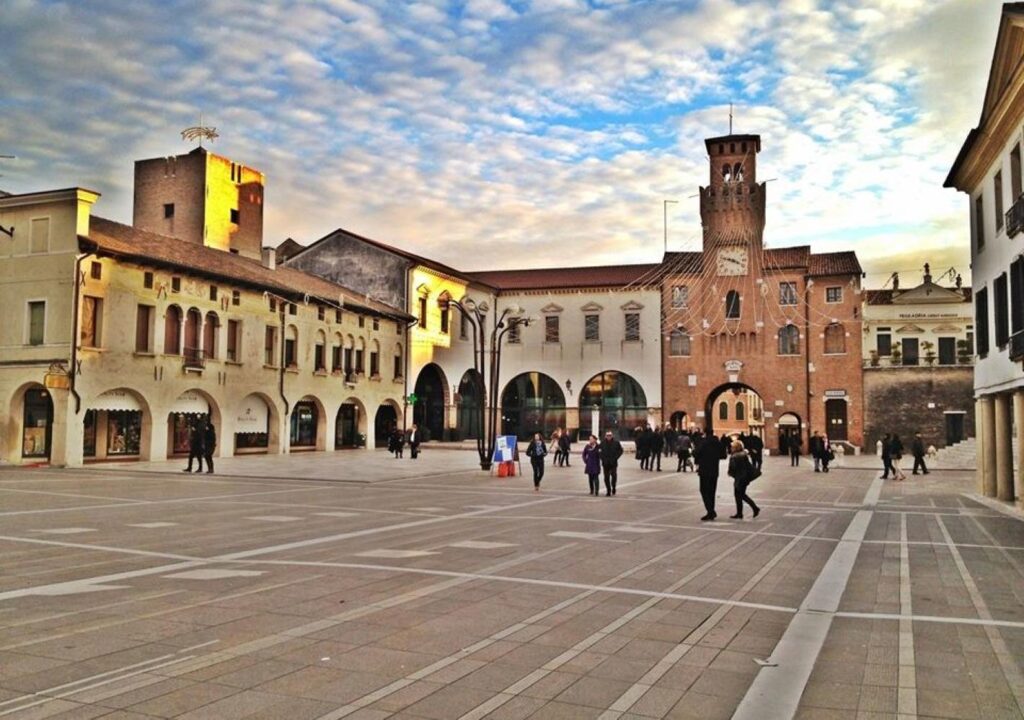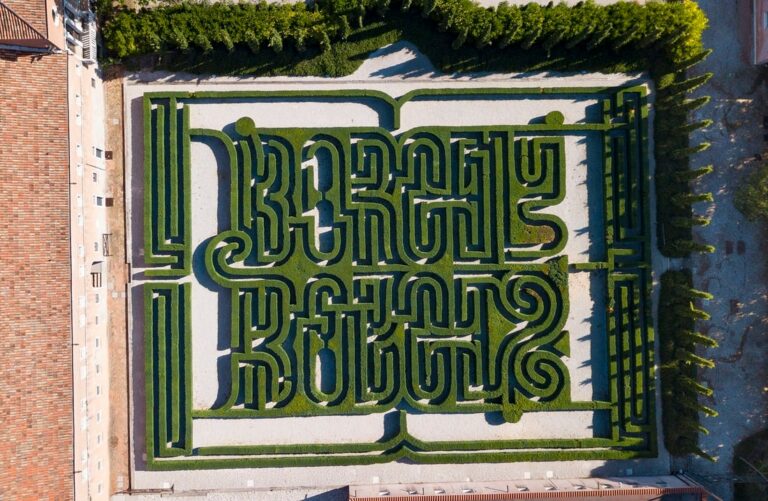Oderzo “Archaeological City” and “City of Art”
nominated by the Italian Touring Club
“Most arcaded city in Italy”
Between the two rivers Piave and Livenza there is a flat land with original colors and landscapes, cultivated with arable land and vineyards and crossed in the middle by a third river: the Monticano.
Here stands the city of Oderzo, with its ancient paleo-Venetian origins and a town of great importance in Roman times. The name of the city derives from the Latin Opitergium which in turn derives from the Venetian Opterg, or “Market square”.
Oderzo, right from the name therefore testifies to its centrality in the territory.
Oderzo is after Verona, the second most important Venetian city of archaeological finds from the Roman age, collected and visible in the Civic Museum and preserved in interesting itineraries in the city itself, while its Paleoveneto monument is the Mutera di Colfrancui, near which the Navisego flows. / Piavon.
The prestigious shops, the schools, the remarkable weekly market (every Wednesday) of livestock and goods and the industrial growth, confirm over time the role of commercial and service center. The city develops around Piazza Vittorio Emanuele II, where the main monuments are located: tradition has it that the Cathedral of San Giovanni Battista, already a bishopric in the early centuries of Christianity, was built on a pre-existing temple of Mars.
To visit the ancient municipal loggia, the Torresin, and Palazzo Ottoboni, frescoed on the outside.
The town extends through an original urban fabric, with streets surmounted by arcades and buildings, which line the waterways, with charming alleys, called Contrade, such as Contrada Rossa and Contrada del Cristo. The most important artery is Corso Umberto I, overlooked by houses and buildings from the 1400s – 1500s.
Important Palazzo Foscolo, seat of the civic Pinacoteca Part of the archaeological finds are preserved in the Civic Museum. Other remains of Roman buildings make up an archaeological itinerary that leads to the Roman Forum between via Roma and via Mazzini with the remains of a basilica and shops; at the foundations of walls, palaces and villas paved with other admirable mosaics. In addition, you can admire the thermal baths of the first century AD. in via Savonarola and in via Spinè the necropolis.
Oderzo was nominated by the Italian Touring Club “Most arcaded city in Italy”: the arcades are in fact one of the symbols of the city, and practically all the buildings in the historic center and the palaces built in the last forty years are equipped with them.
To be seen
Piazza Grande
Formerly Piazza Vittorio Emanuele II, it is one of the most famous squares in Veneto due to its particular stage shape, and is the backdrop to numerous cultural initiatives.
In the eastern part of the square there is an eight-shaped curve: commonly called “the sundial”, it is a large analemma, which acts as a calendar thanks to the shadow of the central pinnacle of the Cathedral.
Piazza Grande is overlooked by the Cathedral of San Giovanni Battista, the Torresin, the ancient Loggia Comunale, the Torresòn and other historic buildings, including the Saccomani Palace and the historic Caffè Commercio.
Eno Bellis Civic Museum
It is one of the oldest in Italy, having been founded in 1876. In 1999 it was moved to the “Barchessa” of Palazzo Foscolo, restored for the purpose. In continuous preparation, it houses only a small part of the great archaeological heritage that emerged from the subsoil of Opitergine and is currently being refurbished. Not far away there is also the art gallery.
Archaeological sites
They are scattered throughout the town, here are a few:
The area of the Roman Forum (between via Roma and via Mazzini). These are the remains of a forensic complex of the Augustan age and of a large domus, located at the intersection of the two main city roads, discovered between 1978 and 1995. The remains of a square are preserved (probable measurements 40 × 100 meters ), the remains of the civil basilica and an imposing staircase.
The area of the former prisons (Calle Pretoria) is located inside a well-known restaurant located in the “Torreson”. It is made up of artifacts and masonry from various eras, plus the remains of medieval prisons.
Via dei Mosaici area. It preserves the lower part of two wells, as well as the mosaic flooring of a domus, investigated between 1951 and 1988.
Area between Piazza Grande and Piazza Castello. It is a tunnel created in the modern building located between the two squares. Crossing it you can see the remains of one of the two main axes of the city and a pavement exposed on the wall.
Via Dalmazia area. Discovered in 1989, it consists of the lower part of a well.

Cathedral of San Giovanni Battista
Begun around the 11th century and consecrated in 1535 to St. John the Baptist, it was built on the ruins of an ancient temple of Mars. The original appearance, in Romanesque-Gothic style, has been heavily compromised by the works carried out over the centuries. The last major restoration dates back to the 1920s, and contributed to restoring the ancient conformation of the building as much as possible. Inside there are some valuable works by Pomponio Amalteo, one of which is a copy of an original exhibited at the Pinacoteca di Brera in Milan. The bell tower was built in the sixteenth century on the basis of a tower of the old city walls, and has a slope of 98 centimeters.
The “Torresin”
It is the symbol of the city: it is a clock tower completely rebuilt in the thirties of the twentieth century and renamed Torre Littoria. It served as an entrance door and constituted a real wall that has been preserved over the centuries.
Old Town
It includes the Roman, Medieval and Renaissance part of the city. It is concentrated around via Alberto Martini and via Umberto I, cobbled streets, flanked by frescoed palaces made from the fifteenth to the eighteenth century.
Palazzo Porcia and Brugnera
It is the sixteenth-century residence of the family of the same name, restored in 2005. It is located in Piazza Castello and is a periodic venue for art exhibitions.
Ca ‘Diedo Park
Find a location in a prominent area of the city. Inside there is a monument dedicated to Luigi Luzzatti, deputy of the Oderzo district and Prime Minister from 1910 to 1911. The park extends over a very large area.
Church of Santa Maria Maddalena
It belonged to a monastery suppressed by Napoleon; it is called “the pantheon of opitergini” for the tombs of illustrious citizens contained within it.
Palazzo Foscolo
Restored after a fire in 1983, numerous cultural and conference events take place at Palazzo Foscolo. It is also the permanent home of the Alberto Martini Art Gallery, a museum containing a collection of paintings by the homonymous painter from Opitergine, as well as other painters from Oderzo and the area. It is located in via Garibaldi.
Villa Stefanel, formerly Berti, formerly Wiel
Villa Wiel Berti Stefanel, is a 19th century Venetian villa, located in the square of the same name, near the railway station; in 2003 it hosted King Juan Carlos of Bourbon.
Surroundings of Oderzo
“Mutera” of Colfrancui, near the homonymous hamlet. It is a mysterious artificial hill from the Venetian era, perhaps used as an astronomical observatory. Keep the remains of a knight and his horse.
The Beekeeping Museum. It is a unique museum of its kind in Italy, and is based in Piavon at the “G. Cerletti “, a branch of the ancient Conegliano Wine School.

History of the city
Peacefully incorporated into the area of influence of the Roman Republic, in 49 BC, thanks to the Lex de Gallia Cisalpina it obtained the status of municipium. It will reach its peak in the 1st-2nd century – it is assumed that at that time the city had about 50,000 inhabitants. The importance was such that at the time the Venice Lagoon was called opitergina, and the mountains of Cansiglio Monti opitergini. Various authors name the city; among them: Ptolemy, Strabo, Pliny the Elder, Lucan, Tacitus, Tito Livio and Quintiliano.
From this moment on, Oderzo is fully part of Rome and participates in its own fate, suffering for centuries the heavy consequences of the barbarian invasions and the wars between the Byzantines and the Lombards: it will begin to recover very slowly only after the year 1000, without more ‘still return to the ancient glories.
It was disputed by the great feudal families of the area, in particular by Camino, Collalto and Scaligeri, until in 1380 it passed under the control of the Republic of Venice. This will last almost uninterruptedly until the arrival of Napoleon (1797). The city then became Austrian in 1815 and Italian in 1866. In this period the city suffered the consequences of the phenomenon of emigration.
In 1917, the retreat of Caporetto brought serious damage to the city, including the destruction of the municipal archive and the destruction of various artistic and architectural works. Starting from 1943, like the whole area, it was the scene of very bitter clashes between fascists and partisans that culminated in the Brandolini massacre.




